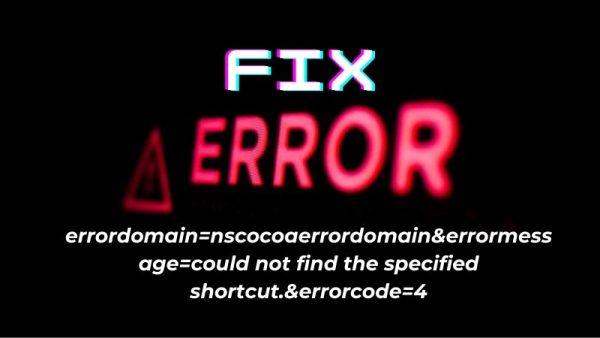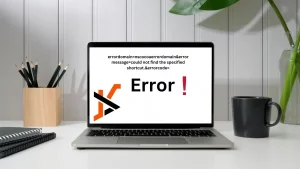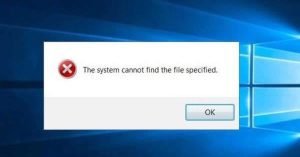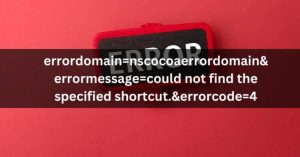
Introduction:
errordomain=nscocoaerrordomain&errormessage=could not find the specified shortcut.&errorcode=4, In the realm of software development, errors and exceptions are inevitable challenges that developers often encounter during the development lifecycle. One such error that developers working with Apple’s ecosystem may come across is the NSCocoaErrorDomain error with error code 4, accompanied by the error message “Could Not Find the Specified Shortcut.” This error is a part of Apple’s Cocoa framework, which is integral to macOS, iOS, watchOS, and tvOS application development.

In this article, we will delve into the intricacies of NSCocoaErrorDomain, explore the possible causes behind the error code 4, and discuss effective strategies for resolving it.
Understanding NSCocoaErrorDomain:
NSCocoaErrorDomain is a constant defined in the Cocoa framework, specifically within the NSError class. It is part of Apple’s Cocoa error-handling system, providing a way to categorize errors that occur within the Cocoa API. When an error occurs, an NSError object is typically created with information about the error, including the error domain, code, and a user-readable error message.
Must Read=Monasterio benedictino de San Nicolò l’Arena (Monastero Benedettini di San Nicolò l’Arena)
NSCocoaErrorDomain is designed to handle errors related to Cocoa and Cocoa Touch frameworks, encompassing various aspects of application development, such as file management, networking, and user interface interactions. Error code 4 within NSCocoaErrorDomain specifically indicates a problem with finding the specified shortcut, a scenario that can manifest in a variety of contexts.
Possible Causes of NSCocoaErrorDomain with Error Code 4:
- Missing or Invalid Shortcut Configuration: One common cause of this error is the absence or incorrect configuration of shortcuts within the application. Shortcuts are user-defined or system-defined key combinations that trigger specific actions. If the specified shortcut is not properly configured or is missing, the application may throw this error.

- File System Issues: The error may also be related to file system problems, such as the absence or corruption of files associated with the specified shortcut. This could occur if the application relies on specific files to define and handle shortcuts, and these files are not accessible or have become corrupted.
- User Permissions: In some cases, the error might be tied to insufficient user permissions. If the application requires certain privileges to access or modify files related to shortcuts, and the user does not have the necessary permissions, the error may occur.
- Platform-Specific Differences: Cross-platform development can introduce inconsistencies, leading to errors like NSCocoaErrorDomain with code 4. It’s essential to ensure that the application is handling platform-specific behaviors correctly and that shortcuts are defined in a way compatible with the target platform.
Resolving NSCocoaErrorDomain with Error Code 4:
- Verify Shortcut Configuration: Begin by reviewing the shortcut configurations within your application. Ensure that shortcuts are properly defined, and there are no typos or mistakes in the configuration. If possible, provide a user-friendly interface for users to customize or review shortcut settings.
- Check File System Integrity: Perform a thorough check of the file system associated with the specified shortcut. Ensure that all necessary files are present, accessible, and free from corruption. Implement error-checking mechanisms within your application to handle file-related issues gracefully.
- Review User Permissions: Verify that your application requests and handles necessary permissions appropriately. If specific actions related to shortcuts require elevated privileges, prompt the user for the required permissions and provide clear instructions on how to grant them.
- Address Platform-Specific Differences: If your application is designed for multiple platforms, thoroughly test and adapt shortcut functionalities to match the specific behaviors of each platform. Consider platform-specific code or configurations to ensure a seamless experience across different operating systems.
- Implement Robust Error Handling: Enhance your application’s error-handling mechanisms to provide meaningful feedback to users when the NSCocoaErrorDomain error with code 4 occurs. Include descriptive error messages and, if applicable, guidance on resolving the issue.

FAQ
1. What does the error message “Could not find the specified shortcut” mean in NSCocoaErrorDomain with error code 4?
The error message indicates that an attempt to locate a specific shortcut failed within the Cocoa framework.
2. In which contexts might I encounter the NSCocoaErrorDomain error with error code 4?
This error is often encountered in applications developed for macOS, iOS, watchOS, and tvOS, where shortcuts play a role in triggering specific actions.
3. What could be the possible reasons for getting this error?
Common causes include missing or misconfigured shortcut settings, file system issues, insufficient user permissions, and platform-specific differences.
4. How can I check and configure shortcuts in my application to prevent this error?
Review and verify the shortcut configurations within your application, ensuring accurate definitions and configurations.
5. Are there specific files associated with shortcuts that I should check for in case of this error?
Yes, file system issues might contribute to this error. Check for the presence and integrity of files related to the specified shortcut.
6. Can user permissions affect the occurrence of NSCocoaErrorDomain with error code 4?
Yes, insufficient user permissions might lead to this error, particularly if your application requires elevated privileges for shortcut-related actions.
7. Is this error platform-dependent?
It can be, especially in cross-platform development. Ensure that your application handles platform-specific differences in shortcut behavior correctly.
8. How can I prompt users to grant necessary permissions for shortcut-related actions?
Implement clear and user-friendly prompts within your application, guiding users on how to grant the required permissions.
9. Are there any recommended practices for handling file system issues related to shortcuts?
Implement thorough error-checking mechanisms in your application to gracefully handle file-related issues, providing informative error messages to users.
10. Can I customize or allow users to define their own shortcuts to avoid this error?
Yes, providing users with the ability to customize shortcuts can be a preventive measure. Ensure that your application handles user-defined shortcuts appropriately.
11. Does this error impact specific versions of macOS, iOS, watchOS, or tvOS?
It may be consistent across versions, but it’s essential to test and adapt your application for compatibility with different operating system versions.
12. How can I enhance error messages to make them more informative for users encountering this issue?
Include descriptive error messages with guidance on how to resolve the issue, offering users clear instructions.
13. Are there any debugging tools or techniques specifically useful for troubleshooting NSCocoaErrorDomain with error code 4?
Utilize debugging tools provided by the development environment and frameworks, and implement logging to capture relevant information during runtime.
14. Can third-party libraries or frameworks contribute to this error?
Yes, especially if they interact with the shortcut system. Ensure that third-party components are compatible with the Cocoa framework.
15. Is there a possibility that antivirus or security software could interfere with shortcut functionalities?
In rare cases, security software might interfere. Consider checking for conflicts and providing guidance on configuring security software appropriately.
16. What precautions should I take during updates or migrations to prevent this error from occurring?
Thoroughly test your application after updates or migrations to ensure that shortcut-related functionalities remain intact. Update configurations if necessary.
17. How can I handle backward compatibility to ensure that users with older system versions do not encounter this error?
Implement version-specific checks and handle backward compatibility gracefully, providing fallback mechanisms if needed.
18. Can network-related issues contribute to NSCocoaErrorDomain with error code 4?
While less common, network issues might indirectly impact the availability of files or configurations related to shortcuts.
19. Are there any community forums or resources where developers discuss solutions to NSCocoaErrorDomain errors?
Explore developer forums, Apple’s developer documentation, and online communities for insights and potential solutions to this error.
20. How often does Apple release updates or patches addressing issues related to NSCocoaErrorDomain with error code 4?
Check Apple’s release notes and developer documentation regularly for information on updates, patches, and bug fixes related to NSCocoaErrorDomain and error code 4. Keep your development environment up to date to benefit from the latest improvements and bug fixes.
Conclusion:
NSCocoaErrorDomain with error code 4, indicating a failure to find the specified shortcut, is a challenge that developers may encounter in Cocoa-based applications. By understanding the potential causes and implementing effective resolution strategies, developers can enhance the robustness of their applications and provide users with a smoother experience. Thorough testing, user-friendly error messages, and diligent attention to shortcut configurations are key elements in addressing and preventing this particular error.


